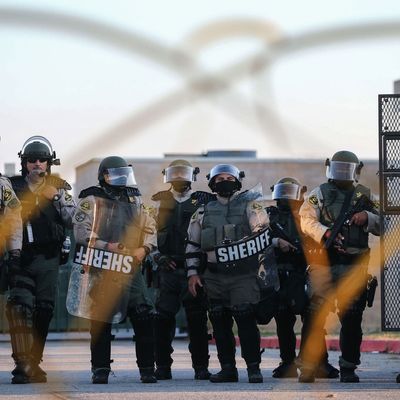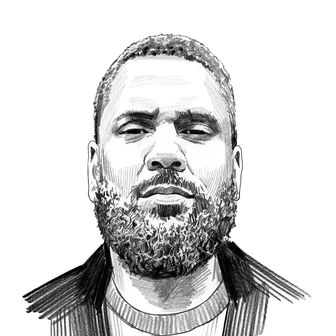
Much of the recent debate about policing’s excesses involves a clash of two viewpoints: one claiming that there is something structurally and culturally wrong with American law enforcement that encourages immoral behavior, and another that attributes their worst conduct to “bad apples,” rogue individuals whose actions speak for them alone and do not indict their fellow officers or their profession as a whole. The Los Angeles County Sheriff’s Department provides a helpful literalization of the former point: an entire law-enforcement entity whose members regularly join criminal gangs, earn clout by harassing, assaulting, and killing county residents, and retaliate against their colleagues who dare to oppose them.
Sworn testimony made in June by a whistleblower, Deputy Art Gonzalez, details a pattern of such behavior inside the Compton sheriff’s station, which exists as part of the Southern California city’s partnership with the county sheriff to provide local law enforcement. Gonzalez claimed that Deputy Miguel Vega, who shot 18-year-old Andres Guardado during a June incident that sparked protests, was a prospective member of the Executioners, a dozen or so deputies who allegedly operate as a gang — setting illegal arrest quotas, threatening work slowdowns if they don’t get their desired shift assignments, assaulting their fellow deputies, and holding parties to celebrate when their members shoot or kill someone in the line of duty, the Los Angeles Times reports. The existence of the Executioners is “common knowledge” within the department, Gonzalez said, according to Spectrum News 1, which obtained a transcript of his testimony this week. Decades of harassment and violence at the hands of the Compton office — including one 2019 incident where the city’s mayor, Aja Brown, claims to have been ordered out of her car by more than half a dozen deputies and searched for drugs that she did not possess — have led the city to propose severing ties with the department altogether, a proposal that the Executioners revelations stand to accelerate. According to the whistleblower complaint, Deputy Vega, who shot Guardado six times in the back, was “chasing ink” — a term used to describe efforts to impress the Executioners in order to be drafted into their ranks and obtain their signature tattoo: a skeleton backed by flames, brandishing a rifle and wearing a Nazi-style helmet.
Part of what makes this dynamic notable is how ordinary it is. Though the central allegation is that the Executioners “dominate” the Compton sheriff’s office, at least nine other such gangs are known to operate across the department, and have done so for decades. “Vikings, Reapers, Regulators, Little Devils, Cowboys, 2000 Boys and 3000 Boys, Jump Out Boys, and most recently the Banditos and the Executioners,” Matthew Burson, chief of the department’s professional standard division, told KABC last month of the LASD’s gang problem. “I am absolutely sickened by the mere allegation of any deputy hiding behind their badges to hurt anyone.” Sheriff Alex Villanueva has said he intends to fire or suspend more than two dozen deputies involved in a widely covered assault on four non-gang members at an off-duty party in 2018. Villanueva was elected under immense pressure to clean up the department, whose former heads — Lee Baca and his undersheriff, Paul Tanaka — were convicted of obstructing a federal probe of abuses in the county’s jail. Tanaka was an alleged member of the Lynwood Vikings, a white supremacist sheriff’s gang. Villanueva has also said that he will implement measures to discourage deputies from joining these cliques at all, but county Inspector General Max Huntsman said last month that he’d seen no evidence of this actually happening. The fallout has been costly on several fronts. Since 2010, misconduct claims linked to these sheriff’s gangs have cost the county $21 million in settlements and associated legal costs, according to the Los Angeles Times.
It’s hard to make sense of this phenomenon without acknowledging that discrete individual malfeasance is insufficient for explaining its scope and longevity. The existence of ten or more gangs operating within the law-enforcement agency that patrols America’s most populous county, and whose members have occupied its highest ranks, indicates a level of tolerance and normalization that cannot be isolated to any one person, and a scale of public danger that cannot be calculated in mere dollar amounts or police shooting statistics. These gangs have been implicated in sustaining an environment of terror, and are regularly celebrated and rewarded for it. Their existence, and seeming intractability, are stark manifestations of the ways that American law-enforcement agencies operate as fraternities the nation over, with less regard for public partnership than for capitalizing upon their own impunity. This is perhaps most evident in the conduct of police unions. But survey any heavily patrolled community and it becomes clear that the existence of police gangs are not necessary to promote illegal arrest quotas, work slowdowns, or internal plaudits for acts of brutality — though gangs are an especially brazen way of formalizing them. This is simply the reality of policing.
It is also incompatible with the arguments made by champions of “bad apple” theory — chief among them President Trump, who this week equated killings by police to having a bad golf game. “The police are under siege,” he said during a Monday interview with Fox News’ Laura Ingraham. He continued:
They can do 10,000 great acts — which is what they do — and one bad apple. Or, you know, a choker. They choke. Shooting a guy in the back many times — I mean, couldn’t you have done something different, couldn’t you have wrestled him, you know? I mean, in the meantime, he might’ve been going for a weapon, there’s a whole big thing there. But they choke. Just like in a golf tournament, they miss a three-foot put —
“You’re not comparing it to golf,” Ingraham interrupted, denying what Trump was literally doing. “I’m saying, people choke,” he replied. “People choke.”
Framed in this way — which, despite its trivialization of homicide, is an apt distillation of what is commonly being asserted when people argue that police abuse is aberrant and discrete — the inadequacy of this explanation is made obvious. It’s also cynical. Trump has pegged much of his reelection campaign’s success to a performative support of the police, lying that his Democratic opponent, Joe Biden, wants to defund them, and characterizing calls to rein in officer misconduct as unduly prohibitive, even as he’s promoted better credentialing and data-keeping practices. Officers have reveled in these lies and rewarded him with their fealty. “New York’s finest I love,” he remarked on August 14, accepting the endorsement of the Police Benevolent Association in New Jersey. “And you’re the finest, they just don’t let you do your job. They won’t let you do your job.” Thunderous applause greeted him. In fact, the NYPD — whose members the PBA represents — have spent years subjecting Black and Latino New Yorkers to a law-enforcement regime marked by routine violence and harassment, such that the mere act of walking down the street was functionally criminalized. Few professions enjoy such broad discretion and unaccountability. Fewer still enjoy the benefit of having their deadly fecklessness waved off as a bad round of golf. The particular incentive structure that governs gangs like the Executioners may be eye-catching in its boldness. But it also typifies policing in places where they do not proliferate so literally, where the apples rot in bunches but are rarely deemed so bad they can’t be fed to the public.






























